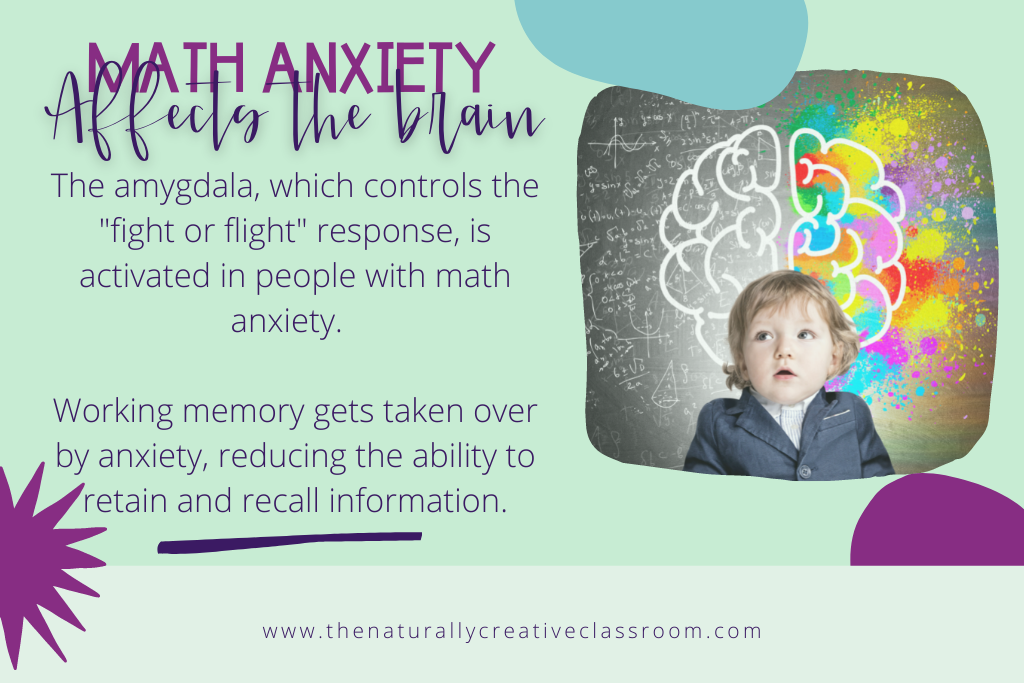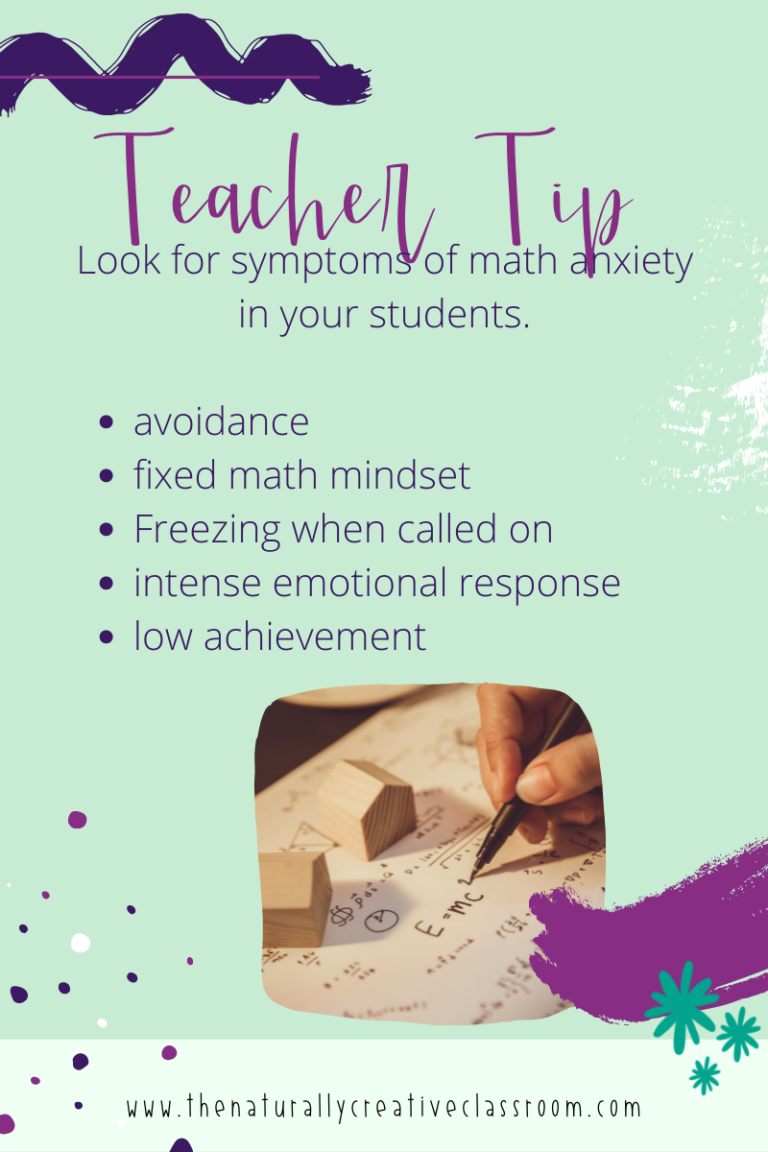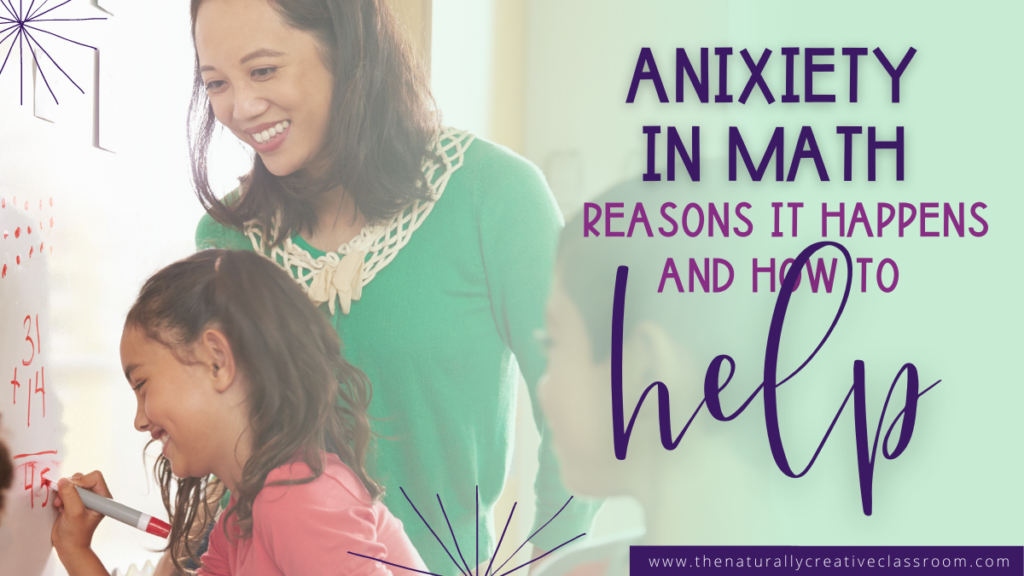What is math anxiety?
Do you have anxiety in math? Imagine you are in fourth grade, and your teacher hands out a sheet of math problems. You immediately get clammy hands, your heart rate increases, a feeling of lightheadedness comes over you, and you grab your stomach and want to run to the bathroom.
Sound familiar? You may have math anxiety.
By some estimates, some degree of math anxiety exists in 93% of the population. 93%! Math anxiety is even considered a diagnosable condition by some mental health professionals.
Anxiety in math occurs much more frequently than anxiety in any other subject. Part of this is related to the way we see math as a culture. Think about how reading is introduced to kids- it is seen as a joy, a necessity, introduced in infancy, and viewed as essential to success. On the other hand, math is often viewed as frustrating, boring, and absolutely irrelevant for anyone except for a few elites who pursue a job in mathematics. No wonder so many people have such a discordant relationship with math!
Math Anxiety Definition
Math anxiety is defined as “the panic, helplessness, paralysis, and
mental disorganization that arises among some people when they are required to solve a mathematical
problem” -Tobias and Weissbrod
“A feeling of tension and anxiety that interferes with the manipulation of numbers and the solving of mathematical problems in a wide variety of ordinary life and academic situations.” – educational psychologist Frank Richardson and counseling psychologist Richard Suinn
In other words, this sounds a lot to me, like the reaction someone should have when encountering an angry bear, not just an everyday math problem!
When experiencing math anxiety, individuals truly feel they cannot do the math problem.
A quick history of anxiety in math
It is understanding the “why” behind things is so fascinating and opens an avenue to change (teaching the “why” is also an essential step in helping overcome math anxiety).
In the early 1900s, when professors came together to develop the views and educational thought that would set the stage for educational practices for the next century, mathematics was off to a bad start right out of the gate. The general consensus was that math was unnecessary and valueless. The educational community at the time deemed math was useless to 90% of men and 99% of women and went about developing a curriculum along these thought lines.
Of course, this line of thought had its detractors. The National Council of Teachers formed in dissent and thought math should be taught to everyone, not just those going into technical fields. Unfortunately, old habits die hard. While we no longer use horses as a primary form of transportation, we send texts instead of letters by mail, and we still hold a negative view of mathematics in our educational system.
For example, a recent survey showed that only 50% of teachers thought that math should help students understand “math concepts and structures,” a full 37% said that math should be limited to basic algorithms and then offered only to students with high math ability. Still, 7% responded that math is only a gatekeeper to college and necessary for doing well on the SAT or college entrance exams.
Luckily, there are ways to identify anxiety in math to support those who suffer from it.

How math anxiety in adults affects children
You guessed it! One of the most common causes of math anxiety in children is math anxiety in adults. Teachers who have math anxiety often choose to teach lower grades where knowledge of basic math is required. Those teachers with math anxiety choose to teach upper grades are more likely to stick to the given script and discourage questioning so that they aren’t asked a question they don’t know the answer to. Even though these teachers try to hide their negative attitudes towards math, students still pick up on it. Teachers with high math anxiety have students who score lower on standardized math tests.
Another source of math anxiety is parents. Many parents don’t talk about math, feel confused by “the new math,” or express their negative attitudes towards math to their children. Their children carry these attitudes into the classroom.
Other causes of math anxiety include the pressure of the timed test and the myth that boys are naturally better at math than girls.
What happens in the brain during math anxiety with students?
In a sample of math anxiety questionnaires of young children, nearly half of first graders reported having some level of math anxiety. Scientists aren’t sure exactly when math anxiety starts, but it affects kids as young as six or seven.
When a student is experiencing math anxiety, working memory is greatly affected. Working memory is like a “mental scratchpad” when we can store bits of information, such as numbers and steps to solving a problem, for a short amount of time. If a teacher reads out or displays a math problem on the board, students with low or no math anxiety use their working memory to solve the problem.
In students experiencing high math anxiety, their working memory is taken up by the fear, literally leaving them no space to store the information they need briefly. Another interesting thing that happens in the brain, discovered when kids were asked to do math in an MRI, is that math anxiety triggers a response from the amygdala. The amygdala is the part of the brain that controls the “fight or flight” response.

Identifying math anxiety symptoms in Elementary Students
When we can identify students who experience math anxiety, we can begin to support them through it. There are several signs and symptoms to look for, and I’m sure you will immediately identify a few students in your class (or yourself) with these symptoms. In contrast, you may think that you should only be looking at the low achievers, four out of five high achievers in math experience some level of math anxiety.
Avoidance
Avoidance can look like a few different things. Do you have a student who always asks to go as soon as math starts no matter how long ago the last bathroom break? For those with severe math anxiety, they may be experiencing stomach upset. Maybe it’s the student who sits quietly in class, appearing to be doing their work, but when you walk over, they are doodling on the page, not having completed one problem. Another way avoidance can look misbehaving and off-task behavior, such as pounding on a desk or making noises. All of these students are looking to avoid math at all costs.
Avoidance can carry on through high school and college, with students avoiding math at all costs. These students take little to no math throughout their educational career if given a choice. I think of my college schedule, and I was an English major and only took one math class throughout college- theoretical geometry. It was frustrating, difficult and only reinforced my then attitude towards math.
Fixed Math Mindset
In her work, Carol Dweck talks about a “fixed mindset” versus a “growth mindset.” A “growth mindset” is believing that with practice, you can get better at anything. You are not “born a math person”; you get better at math with practice. Those who suffer from math anxiety have a “fixed mindset” regarding math. They feel that no matter what, they will never be good at math. This mindset keeps them back from developing their abilities in math.
To identify students with a fixed math mindset, listen for negative self-talk such as “I can’t do this,” “I hate math,” “I’m not good at math.”
Freezing
I know this is a reaction that I have seen a handful of times in the classroom. It’s when you call on a student, and they stare at you. They will not answer the question. Freezing is thought to be due to the lack of working memory. The student may know the answer to the question, but they can’t think clearly enough to answer.
Intense Emotional Response
Some children have an emotional response to math that includes anger, tears, or panic. Students respond like this because there is a widely held belief among children and adults that math questions must be answered quickly and with 100% accuracy.
Low Acheivement
Remember how four out of five students with math anxiety are high achievers? Well, over the years, the feelings above can interfere with their achievement in math and, ironically, become a self-fulfilling prophecy. Students with math anxiety have less exposure to math education, leading to difficulty on tests, leading to reaffirming low test scores confirming they are “no good at math.”

How to help math anxiety
Thankfully, all hope is not lost, and no matter how old you or your students are, you can work to overcome your fears about math (growth mindset!). Below are some strategies that have been shown effective in reducing math anxiety.
Be playful with math
Starting at a very young age, parents can be playful with math at home. You can play games with your young kids that involve math. From games like “bring me five” to reading books that explore shapes, there are many things you can do at home to support early math skills. Here is a nice list of 15 toddler-focused math games.
If you have older kids, you can still be playful with math. This can include simple card games like multiplication or addition “Top-it” (I like that name better than war). Divide the deck, and each person puts down two cards, and they must multiply or add, and whoever has the highest number wins. Top-it can also play this game with Dominoes.
Many math games are available in stores, such as Yahtzee, Uno, Math Dice, Quix (one of my favorites), Muggins, and Mastermind. While you may need to learn a few new rules, these games are great for family game nights or fill some time in the afternoon instead of being on screens.
Playing math games has been shown to have many benefits such as increased engagement, higher retention and a reduction of anxiety in math. Read more about the benefits of math games here.
My store offers a wide variety of math puzzles and games. As a kid, these were super motivating for me. Some of my favorites are the secret codes I have created. Not only will you find substitution codes, but also tap codes and ciphers to keep your students engaged. They cover a wide range of skills such as addition, subtraction, multiplication, division, missing number equations, and rounding. Students must solve the problems to break the code. You can find them here.

Don't Spread Common Math Myths
Spreading common math myths only increases the incidences of anxiety in math in kids. These include (but are not limited to):
- Boys are naturally better at math than girls
- You are either born a math person, or you are not
- If you can’t do math now, you will never be able to do it
- Math is useless in everyday life
Write it out
Encourage your students to write about their math anxieties and fears before a math test. Doing this has been shown to help improve scores.
Breathing Exercises
Deep breathing exercises are well known to help ease anxiety and can help students before a math lesson or test. My favorite app is Calm and I used meditation in my own classroom to help calm a rowdy bunch of fourth-graders. The app has meditations designed especially for kids and is free for educators.
Teach the Why
Teach and help students understand the why behind math. Why is 1/3 equivalent to 2/6? Why do we regroup in 3 digit addition? This particular strategy hits home for me. Kids with math anxiety often think of math as a series of unrelated steps that you have to memorize. I was a top achiever in math class, but this was precisely how I felt about math. I was good at memorizing steps but did not see the connection between the operations.
While teachers may think that sticking to the strategies and algorithms is in the best interest of a low achieving math student, teaching the why will empower them.
Give Plenty of Think Time to Ease Anxiety in Math
Before you call on a student to answer a math problem, give plenty of think time. When my kids are sitting on the rug for number talks, I have them put a thumbs up on their chest when they have solved the problem and are ready to talk about it. I wait until most kids signal they are ready. If a student needs a pencil and paper to help them solve, let them use it, at least temporarily, to boost their confidence.
Use Mixed Ability Grouping
I know that this one is a little more controversial than some of the others as the research goes in both directions, especially for those at the higher end of the spectrum for math. I have used both types of groupings. It is true that the quality of math instruction is improved in mixed ability groups, but it is also important not to rely heavily on the students with higher math achievement to teach those with lower math achievement. All students should grow one full year in math, so students with high achievement should be pushed farther in math as well.
Show You Value the Process
When choosing work to highlight and display, select work that shows the student took time to follow the process and came at the problem differently. Emphasizing the process will show that you value accuracy and flexible math thinking.

You can learn how to overcome anxiety in math
Anxiety in math is very prevalent in our society. The great news is that you can learn how to overcome your anxiety in math and you can help your students develop a positive math attitude at the same time. Through positive conversations in math, thinking time, to breathing exercises, there are many ways to support your students and their attitudes towards math.



3 Responses